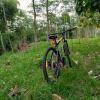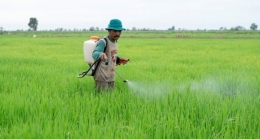COVID-19 pandemic which is originally a health related problem has also became major social and economic problems. With some areas are currently under Pembatasan sosial berskala besar (PSBB) and social distancing protocols are in almost everywhere else, efforts to stop the pandemic has also put many sectors and industries in Indonesia into halt for unforeseeable future.
Some sectors are indispensable and should continue to run though. Agriculture sectors are some of them. However, maintaining agriculture production during social distancing could be difficult. FAO has warned that steps taken to stop COVID-19 spread could also disturb agriculture production and distribution which potentially creates food shortage.
Until now, disruption on agriculture outputs by social distancing protocols has not widespread in Indonesia. Most planting areas continue to harvest as scheduled, even there are reports of rice surplus in regions such as Java, Riau, and West Borneo. However, we must understand that the good harvest we get today were planted and grown several months before social distancing protocols were enacted. The real challenge for agriculture sectors during this pandemic will take place next planting season, especially if prolonged social distancing is still in effect.
To meet demand from fast growing world population, agriculture has also been grown into very large and complex industry which uses large area, employs big workforce and involves input from other industries. At current pandemic situation, the size of planting and farming area is not a big concern since there is no immediate need for large new areas opening.
So is not the needed labor, with many workers are currently unemployed. Government decision to let migrant workers and those that lost job at factories to go back to their village to help protecting national food security is excellent. These workers can temporary provide unskilled labors for agriculture sectors. So, the biggest obstacle to produce high agriculture output could be in the form of obtaining inputs (such as fertilizers, pesticides, seeds) and output (products) distribution.
Many people probably do not realized that agriculture is not kind of industry that can be put into halt at any time when facing obstacle then to be continued at more favorable time. It is different than automotive or electronics production which can be put into halt immediately, in case of lack of components, just to be continued without much damaging the outputs when the required components are acquired.
In agriculture, once planting started, it is expected to go on without pause until harvest. To make it worse, agriculture industry is very slow to produce its output. The production of many staple foods take months even years. Rice, corn, wheat, potatoes, just for example, take 3-6 months until harvest. The same also true in animals farming.
During this lengthy production time, all necessary inputs should be available at correct time and amount, otherwise plants and farm animals will not grow well. Fertilizers, which could be of different types, should be given on time at certain plant growth stages. Pesticides are necessary to continuously maintain low number of pests and pathogens.
Furthermore, a larger amount of pesticides and animal medicines need to be quickly made available during heavy pest infestation or diseases outbreak. Most farmers also do not produce seeds for next planting season, instead they rely on hybrid seeds from seed companies which are cheaper and better in quality. To produce a big amount of high quality seeds with little variations among them itself is a very long and laborious process.
Companies that produce fertilizers, pesticides, animal foods and medicines, and plant seeds in turn rely on other industries which mainly provide chemical components for their products. Some of these chemicals are not produced in Indonesia and should be imported from other countries. Of course, it can be expected that there will be shortage of these chemicals when factories are closed during social distancing protocols.
Signs that inputs shortage and difficulty to distribute outputs will be major disruptions for agriculture sectors were began to be reported. Just recently, thousands of chicks were released to open fields in Kotagedhe, Yogyakarta due to wildly increased of chicken food and medicine prices that made farmers unable to attend the chicks. The sudden highly increase of Bawang bombay price that we experience now is partially caused by obstruction on supply chains since our market depends on import from countries currently under lockdown.
Ministry of Agriculture actually has taken precaution measures to keep agriculture sectors produce enough output during COVID-19 pandemic. It recently proposed additional fund of Rp 6.38 trillion to Coordinating Ministry for Economic Affairs. When approved, Rp 2.24 trillion will be allocated directly to subsidize farmers and protect their products with insurance. The remaining Rp 4.14 trillion will be used as incentive for companies to produce enough amount of agriculture inputs. With this funding, government should have better position to negotiate its policies with those profit oriented companies.
Additional moves are still needed to be taken since Indonesia’s agriculture system is notoriously unable to provide our country ever growing population with enough foods, even in normal times. The lack of input with good quality and enough amount is always one of the reasons behind these failures. So, early on, government and private companies need to list what kind of fertilizers, pesticides, seeds, and other components that will be lacking in the near future then figure out ways to acquire them, including by importing from other countries.
This step will be critical to maintain currently on going productions. In a similar but more immediate approach to protect national food security, government also needs to make sure they can quickly acquire staple foods from foreign countries, should the need arise, since this process usually take long bureaucratic and safety procedures.
Another negative point that persistent in Indonesia’s agriculture is bad distribution system. In many occasions, data shows that there are surplus of certain products nationally, but they are in shortage in some regions, even in those nearby to surplus regions. So, in this time of crisis, the pace and ease to distribute food between areas and to costumers should be increased to avoid pile up in surplus areas while others experience shortage.
Currently, agriculture inputs and products have been allowed by Presidential decree to move freely (as long as following social distancing protocols) between areas under PSBB. It also can be suggested that government provide additional support and specific incentives for distribution companies.
With many markets are still closed, it could be even more difficult to deliver products to costumers. Online system has been tried to solve this problem, but it was reported put more strain on poor people since it potentially increases food prices by adding delivery cost. Government intervention probably is also needed to reduce this delivery cost.
Beside towards health sectors, government also need to shift their focus and priority towards agriculture sectors because food is important factor in successful implementation of social distancing protocols to stop COVID-19 spread in our country. Beside that, strong agriculture sectors can help our economy to withstand the coming and unavoidable slowdown. This pandemic definitely brings many miseries, but the government shift of focus will probably also bring long awaited major improvements in Indonesia’s agriculture. As President Jokowi himself said that this pandemic situation should become a momentum to implement better policies towards our agriculture sectors.











